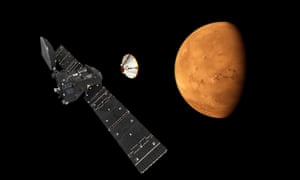Extract from The Guardian
A European spacecraft has detached from its mothership to begin an attempt to make a tricky landing on Mars.
Schiaparelli is the first European Space Agency (ESA) probe in nearly 15 years to try to make contact with the red planet.
The lander is designed to monitor aspects of Martian weather rather than search for signs of life. It will also test out a landing system to be used for a future rover mission that will look for evidence of past or present living organisms.
It is hoped Schiaparelli will fare better than its predecessor, Beagle 2, which vanished on Christmas Day in 2003 after separating from the Mars Express orbiter. The lander is expected to touch down on Wednesday after a three-day descent.
Schiaparelli was launched on 14 March in the first stage of an ambitious joint European and Russian mission to search for the first clear evidence of life on Mars. It has crossed 310 million miles of space in seven months.
Stephen Lewis of the Open University, who co-heads the team that will receive data from the probe’s engineering sensors during the descent, said: “Landing on Mars has always been a perilous endeavour, not least because Mars has an active atmosphere and weather.
“Understanding the atmosphere on Mars now, and how Mars’ climate has changed, is a key part of finding out whether the planet ever had a habitable environment and supports our understanding of our own climate.”
In 2020 a six-wheeled mobile laboratory, ExoMars Rover, will be sent to the planet to drill for samples beneath the surface and analyse them for signatures of life. A key function of Schiaparelli is to try out the rover’s parachute and retro-rocket landing system.
Schiaparelli is the first European Space Agency (ESA) probe in nearly 15 years to try to make contact with the red planet.
The lander is designed to monitor aspects of Martian weather rather than search for signs of life. It will also test out a landing system to be used for a future rover mission that will look for evidence of past or present living organisms.
It is hoped Schiaparelli will fare better than its predecessor, Beagle 2, which vanished on Christmas Day in 2003 after separating from the Mars Express orbiter. The lander is expected to touch down on Wednesday after a three-day descent.
Schiaparelli was launched on 14 March in the first stage of an ambitious joint European and Russian mission to search for the first clear evidence of life on Mars. It has crossed 310 million miles of space in seven months.
Stephen Lewis of the Open University, who co-heads the team that will receive data from the probe’s engineering sensors during the descent, said: “Landing on Mars has always been a perilous endeavour, not least because Mars has an active atmosphere and weather.
“Understanding the atmosphere on Mars now, and how Mars’ climate has changed, is a key part of finding out whether the planet ever had a habitable environment and supports our understanding of our own climate.”
In 2020 a six-wheeled mobile laboratory, ExoMars Rover, will be sent to the planet to drill for samples beneath the surface and analyse them for signatures of life. A key function of Schiaparelli is to try out the rover’s parachute and retro-rocket landing system.

No comments:
Post a Comment